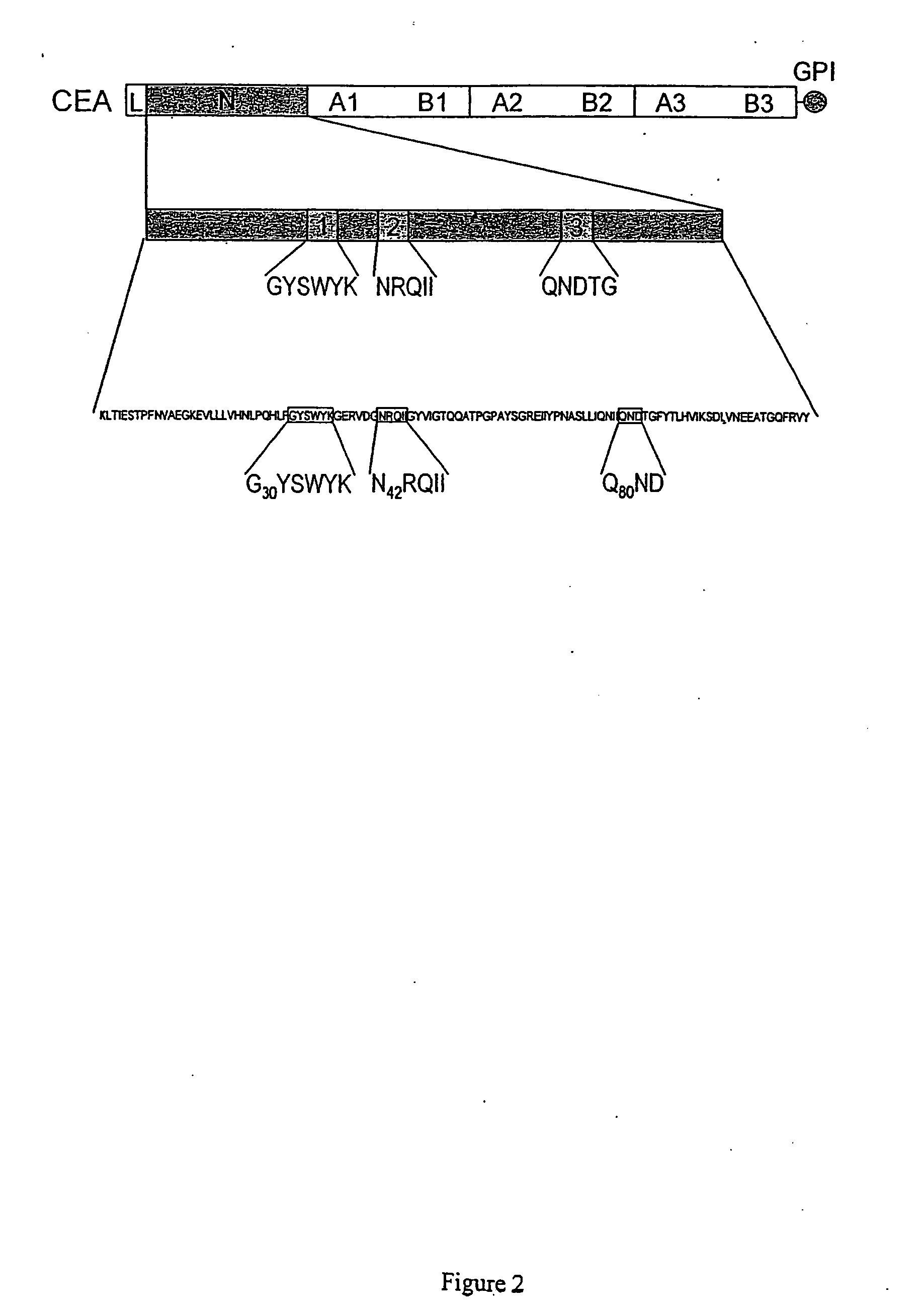CEA binding agents and compositions to reverse CEA-mediated tumorigenic effects on human cancer cells, restore sensitivity to drug induced apoptosis and uses thereof
- Summary
- Abstract
- Description
- Claims
- Application Information
AI Technical Summary
Benefits of technology
Problems solved by technology
Method used
Image
Examples
example 1
Experimental Procedures
[0179] Materials—Cyclized and linear-blocked oligopeptides were obtained (>95% purity) from Multiple Peptide Systems (San Diego, Calif.). Linear-blocked peptides were rendered more stable by acetylating the amino terminus and aminating the carboxy terminus. Cyclic peptides contained two cysteine residues joined by sulfide bonds at their termini. The peptides used were blocked linear NAc-LFGYSWYKGE-NH2, NAc-VDGNRQIIGY-NH2, NAc-RIIQNDTGFY-NH2 and NAc-FNVAEGKEV-NH2; and cyclized H-CGYSWYKC-OH, H-CGNRQIIC-OH, H-CQNDTGC-OH and H-YCTDEKQCY-OH, representing subdomains 1, 2 and 3, and control peptides, respectively. Sequences actually present in the N domain of CEA for the cyclized peptides are underlined.
[0180] Construction of CEA cDNA Mutants—Wild type cDNA coding for CEA (17) was used as a template for all polymerase chain reaction-generated (PCR) constructs. The recombinant PCR technique (25) was used to generate site-directed mutants as described previously (16...
example 2
Nature of CEA Homophilic Intermolecular Interactions Required for Differentiation Block
[0189] To test for a role of parallel CEA-CEA interactions on the same cell surface, differentiation-competent L6 (ΔNCEA) transfectants were treated with cross-linking polyclonal and monoclonal anti-CEA antibodies. Antibodies for which the binding epitopes are still intact in the ΔNCEA molecule, rabbit polyclonal and D14 [binding epitope at the B2-A3 junction (29)], converted ΔNCEA to a differentiation-blocking molecule, whereas control antibodies directed to binding epitopes that are missing in ΔNCEA, A20 and B18, two N-domain specific mAbs, [binding epitopes at residues 35 to 42, in the N domain (16)] were without effect (FIG. 1). To control for non-specific effects, one of the effective antibodies, D14, was shown to have no effect on the differentiation of the parental L6 cells (FIG. 1).
[0190] These experiments and experiments showing the efficacy of trans-blocking support the hypothesis that...
example 3
Structural Requirements for Myogenic Differentiation Blocking Function of CEA
[0191] Deletions and substitutions in three subdomains of the N domain of CEA (FIG. 2) were produced by site-directed mutagenesis, as described previously (16). The rationale for choosing these particular subdomains can be summarized as follows: the requirement for N domain amino acids 32 to 106, deleted in mutant ΔNCEA, for the myogenic differentiation block was demonstrated previously (20). Within this deletion, subdomains 1 and 2 were implicated by the fact that (1) monovalent Fab fragments of mAb A20 can release the CEA-imposed myogenic differentiation block and reverse the CEA-mediated tumorigenic effect (see below) and has a binding epitope that bridges them; (2) this epitope includes the carboxy-terminal amino acid of subdomain 1 and the amino-terminal amino acid of subdomain 2 (16) and (3), these subdomains (1 and 2) and subdomain 3 were all shown to be important in CEA-mediated intercellular adhes...
PUM
| Property | Measurement | Unit |
|---|---|---|
| Electrical resistance | aaaaa | aaaaa |
| Adhesion strength | aaaaa | aaaaa |
| Cytotoxicity | aaaaa | aaaaa |
Abstract
Description
Claims
Application Information
 Login to View More
Login to View More - R&D
- Intellectual Property
- Life Sciences
- Materials
- Tech Scout
- Unparalleled Data Quality
- Higher Quality Content
- 60% Fewer Hallucinations
Browse by: Latest US Patents, China's latest patents, Technical Efficacy Thesaurus, Application Domain, Technology Topic, Popular Technical Reports.
© 2025 PatSnap. All rights reserved.Legal|Privacy policy|Modern Slavery Act Transparency Statement|Sitemap|About US| Contact US: help@patsnap.com



